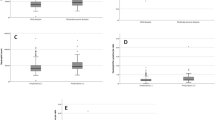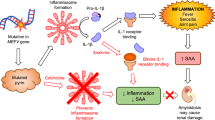Abstract
The most dreaded complication of familial Mediterranean fever (FMF) is amyloidosis; controversy exists as to what acute phase reactant (APR) should be monitored in these patients. To analyze the best acute phase reactant for FMF follow-up to help guide physicians to decide on what APR parameter to use, we also attempted to define the best APR in predicting the complications of FMF, specifically the development of amyloidosis. Systematic review based on a sensitive search to capture studies that: (1) included FMF patients; (2) measured serum amyloid A (SAA), CRP (C-reactive protein), proteinuria, or ESR (erythrocyte sedimentation rate); (3) amyloidosis were the outcome measure; (4) sensitivity, specificity, predictive value, and other performance parameters could be calculated; and (5) had a longitudinal design. Of 1905 captured items, 26 were selected for detailed review, of which only two finally met the criteria, and the quality was only moderate; the articles did not analyzed the performance by means of sensitivity and specificity to predict, or even detect, amyloidosis, and thus had to be calculated based on text. The 26 screened studies were very heterogeneous in designs, parameters measured, and results, despite being set from research questions similar to ours. They were mainly descriptive, and it was very difficult to interpret the true performance of the tests. The correlation between the various APR is low. The evidence supporting the monitoring of FMF with any APR over the others is limited. Well designed longitudinal studies with a mixture of outcomes should be undertaken. Until them, recommending an APR over other would be based on expert opinion and indirect evidence.

Similar content being viewed by others
References
Sohar E, Gafni J, Pras M, Heller H (1967) Familial Mediterranean fever. A survey of 470 cases and review of the literature. Am J Med 43(2):227–253
Akar S, Yuksel F, Tunca M, Soysal O, Solmaz D, Gerdan V et al (2012) Familial Mediterranean fever: risk factors, causes of death, and prognosis in the colchicine era. Medicine 91(3):131–136
Touitou I, Sarkisian T, Medlej-Hashim M, Tunca M, Livneh A, Cattan D et al (2007) Country as the primary risk factor for renal amyloidosis in familial Mediterranean fever. Arthritis Rheum 56(5):1706–1712
Kasifoglu T, Bilge SY, Sari I, Solmaz D, Senel S, Emmungil H et al (2014) Amyloidosis and its related factors in Turkish patients with familial Mediterranean fever: a multicentre study. Rheumatology 53(4):741–745
Tunca M, Akar S, Onen F, Ozdogan H, Kasapcopur O, Yalcinkaya F et al (2005) Familial Mediterranean fever (FMF) in Turkey: results of a nationwide multicenter study. Medicine 84(1):1–11
Zemer D, Pras M, Sohar E, Modan M, Cabili S, Gafni J (1986) Colchicine in the prevention and treatment of the amyloidosis of familial Mediterranean fever. N Engl J Med 314(16):1001–1005
Hentgen V, Grateau G, Kone-Paut I, Livneh A, Padeh S, Rozenbaum M et al (2013) Evidence-based recommendations for the practical management of familial Mediterranean fever. Semin Arthritis Rheum 43(3):387–391
Kallinich T, Haffner D, Niehues T, Huss K, Lainka E, Neudorf U et al (2007) Colchicine use in children and adolescents with familial Mediterranean fever: literature review and consensus statement. Pediatrics 119(2):e474–e483
Chae JJ, Cho YH, Lee GS, Cheng J, Liu PP, Feigenbaum L et al (2011) Gain-of-function Pyrin mutations induce NLRP3 protein-independent interleukin-1beta activation and severe autoinflammation in mice. Immunity 34(5):755–768
Lachmann HJ, Lowe P, Felix SD, Rordorf C, Leslie K, Madhoo S et al (2009) In vivo regulation of interleukin 1beta in patients with cryopyrin-associated periodic syndromes. J Exp Med 206(5):1029–1036
Ben-Zvi I, Livneh A (2011) Chronic inflammation in FMF: markers, risk factors, outcomes and therapy. Nat Rev Rheumatol 7(2):105–112
Kallinich T, Wittkowski H, Keitzer R, Roth J, Foell D (2010) Neutrophil-derived S100A12 as novel biomarker of inflammation in familial Mediterranean fever. Ann Rheum Dis 69(4):677–682
Korkmaz C, Ozdogan H, Kasapcopur O, Yazici H (2002) Acute phase response in familial Mediterranean fever. Ann Rheum Dis 61(1):79–81
Duzova A, Bakkaloglu A, Besbas N, Topaloglu R, Ozen S, Ozaltin F et al (2003) Role of A-SAA in monitoring subclinical inflammation and in colchicine dosage in familial Mediterranean fever. Clin Exp Rheum 21(4):509–514
Lachmann HJ, Sengul B, Yavuzsen TU, Booth DR, Booth SE, Bybee A et al (2006) Clinical and subclinical inflammation in patients with familial Mediterranean fever and in heterozygous carriers of MEFV mutations. Rheumatology (Oxford) 45(6):746–750
Yalcinkaya F, Cakar N, Acar B, Tutar E, Guriz H, Elhan AH et al (2007) The value of the levels of acute phase reactants for the prediction of familial Mediterranean fever associated amyloidosis: a case control study. Rheumatol İnt 27(6):517–522
Ben-Chetrit E, Levy M (1998) Familial Mediterranean fever. Lancet 351(9103):659–664
Berkun Y, Padeh S, Reichman B, Zaks N, Rabinovich E, Lidar M et al (2007) A single testing of serum amyloid a levels as a tool for diagnosis and treatment dilemmas in familial Mediterranean fever. Semin Arthritis Rheum 37(3):182–188
Yildirim K, Uzkeser H, Keles M, Karatay S, Kiziltunc A, Kaya MD et al (2012) Relationship between serum interleukin-1beta levels and acute phase response proteins in patients with familial Mediterranean fever. Biochemia Medica. 22(1):109–113
Tunca M (1999) Acute phase response and evolution of familial Mediterranean fever. Lancet 353:1415
Author information
Authors and Affiliations
Corresponding author
Ethics declarations
Conflict of interest
This systematic review was funded by Eular (European League Against Rheumatism) as part of an initiative to develop recommendations on the management of FMF. Burak Erer has received a research fellow honorarium from EULAR, Erkan Demirkaya has received a research fellow honorarium from EULAR, and Seza Ozen has received research grant from EULAR.
Electronic supplementary material
Below is the link to the electronic supplementary material.
Rights and permissions
About this article
Cite this article
Erer, B., Demirkaya, E., Ozen, S. et al. What is the best acute phase reactant for familial Mediterranean fever follow-up and its role in the prediction of complications? A systematic review. Rheumatol Int 36, 483–487 (2016). https://doi.org/10.1007/s00296-015-3413-z
Received:
Accepted:
Published:
Issue Date:
DOI: https://doi.org/10.1007/s00296-015-3413-z




